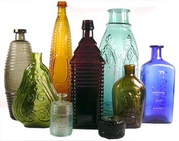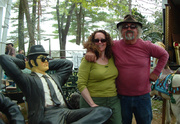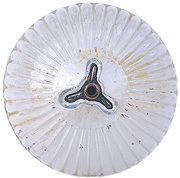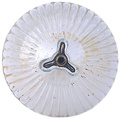In this interview Ian Macky describes the origins, types, shapes and colors of collectible antique glass insulators. Based in Yreka, California, Macky can be reached via his website, Glassian, which is a member of our Hall of Fame.
I got interested in insulators when I lived in El Cajon and my neighbor worked for San Diego Gas and Electric. His son had a bunch of insulators on the window sill in his bedroom. I had never seen them up close before and I really liked glass, especially glass that was found in places you wouldn’t normally see it, like on sidewalks or built into poles, things that glass wasn’t fit for. You always think of glass as being fragile, but it was used for some pretty industrial uses.
So I asked him about them and it turns out all the original insulator collectors were linesmen. They’d go out and do a job and there’d be an old pole with antique insulators on them. They’d swap out the old ones with the new ones and to everybody else, the old were just junk. So my neighbor knew a lot of other insulator collectors and it just went from there. There was a national insulator show in San Diego and even one in my hometown. It seemed like there were shows everywhere and collecting insulators was a common thing.
If only I had money then, I was just a kid and five bucks was a lot of money and ten was way over my price range. Now the prices have gone through the roof because once you get the common insulators, it’s time to go for the rare ones. They’re just so expensive now. I’d say 2 to 3,000 people collect insulators and half of them are really serious and still collecting actively. It’s all about supply and demand, and there isn’t enough supply, especially of the nicer insulators. If you like glass, there are some very beautiful colors of insulators, and people want those rare pieces of glass.
Collectors Weekly: What color and shape of insulators are the most sought after?
Macky: Most people, if they had to thin out their collection, would keep the color. In insulator circles, anything not clear or aqua is considered colored. Aqua and clear were the default colors. Because of the iron content in the glass, most of the insulators came out a little green, that’s the typical aqua color you see and it’s very common. It’s a nice enough color, but when you’re collecting you try to find everything but aqua. If you’re a CD (design-oriented) collector, you try to collect one CD in each style, you’ll find that most of your collection is aqua. Very few insulators were made in colors.
Most of the color is in a few of the styles, especially in the signal insulators that carried railroad signals. They were offered in colors by the factory, you could specifically order blue, amber, or green, which would be helpful if you had a pole with a lot of insulators on it, for marking certain circuits with certain colors. Otherwise, they didn’t try to make insulators in colors because it didn’t matter.
You’d get a few fancy colors because some glasshouse did a fancy batch of cranberry glass or made some colored glassware and had some left over so they pressed a few insulators with it. Most of the glass houses didn’t make only insulators, they’d make all kinds of glassware. That’s why you get fancy colors sometimes. If they had an order for a whole bunch of Cobalt blue candle holders and they had glass left over, they weren’t going to waste it so they would put it towards another glass item, sometimes insulators.
To make insulators they used a lot of cullet, or recycled glass, and every batch of glass has some form of cullet in it because it was a lot more workable. So depending on the cullet that was used, you’d get different colors. Sometimes you’d even get swirls if they didn’t mix it well. There’s a batch of very nice green insulators made by McLaughlin in Vernon, California. He got a truckload of green gin bottles and melted them down and created a batch of insulators. That’s where those nice deep green insulators come from.
Later on the manufacturers decided clear insulators were more practical because they attracted fewer bugs and heated up less. There were a few exceptions later on, when porcelain started taking over for insulators and they tried to duplicate the colors. There’s some black glass out there, which is pretty much late 1960s and they made white milk glass insulators which had a white porcelain look. But those were made later on and essentially those were just black and white to match the porcelain.
The most popular color among collectors is Colbalt blue. That’s one of the colors Hemingray offered for their insulators, there are thousands of them out there. But they are so popular they are all snapped up immediately, everybody wants them.
Collectors Weekly: Who were some of the major insulator manufacturers?
Macky: The biggest and best was Hemingray. They came along in a boom time when gas fields were being found, and cities would offer free gas supply to companies so they’d just follow the gas around. They produced the most different styles and were in production for the longest time. They made color insulators on purpose. They were also the makers of the Hemingray 42, the best selling insulator of all time, produced in the millions. You don’t see a lot of insulators in the air anymore, except at railroads, and they’re mostly Hemingray 42.
Another popular manufacturer was Brookfield in New York. On the West Coast the only people making insulators were EC & M around the 1880s, which is pretty early. They made a really crude, bad insulator, but you didn’t have to ship it from the East. Those are very sought after now; they’re a unique style and a San Francisco product and they come in some very nice colors. But no one has any idea of who actually made them. There were plants all over the place, transportation and fuel were a big factor. You had to be close to a fuel source because of gas and the railroad and that was the market.
Some insulators were embossed with the manufacturer’s name and style number, and perhaps the year or mold number. The molds were engraved so the letters were dug in. There are a lot of unembossed insulators out there, but at the turn of the century there were a lot of engravers and glass makers and cast iron was very big so people were making a lot of molds, and embossing was very big. As the years went on, there were fewer engravers available and the embossing started getting simpler and simpler.
Collectors Weekly: During what time period were insulators used?
Macky: The very earliest insulators were lightning rod insulators. One of the interesting things about insulators is that they parallel the development of electricity. Before people were making electricity, insulators were being used to support grounding rods, just channeling electricity to ground, protecting houses. Later on when the telegraph was invented, suddenly there was a need to run wires on poles for many miles and to develop insulators. They started out small because there was typically only one telegraph line on a pole.
“EC & M made a really crude, bad insulator, but you didn’t have to ship it from the East.”
Then telephones took over and got popular, and there was the Rural Electrification Act, which tried to provide power to all these farm people. So there was a big insulator boom in the early part of the century, they were producing them by the millions. This was during the open wire days. From the 1920s to the 40s, that’s when the peak was. They started tapering off after that.
When I lived in San Mateo a lot of the old glass was still up in the air. There are some very thrifty companies out there, and insulators lasted and they just kept reusing them over and over. But today, if I walk around Yreka, there’s hardly any glass at all, usually for telecommunications they use cables, which don’t need insulators. For the power, they almost exclusively use porcelain. For new construction they will only sometimes use glass on the high power pylons. The glass ones are used a lot more in Canada than here. In other countries, it’s different, they actually use glass, but we use porcelain in America. I think it’s cheaper to manufacturer and mechanically they are a little stronger. The transition to porcelain started in the 1950s and by 1970 they were pretty much done.
Collectors Weekly: What were some of the early, rare insulator designs?
Macky: The earliest design was used on the Morris telegraph and was called a bureau knob because it looked just like a knob on a dresser, just a knob with a groove in it. As soon as the first winter came along, they realized that design wouldn’t work. They discovered very quickly how important weather proofing was. The earlier designs had things called ram’s hooks, a hooked shaped thing down below and the wire would rest on the hook and they had to somehow insulate the hook from everything else.
There’s some crazy designs out there. One of my favorites is from Chicago. It’s claim to fame was that instead of having just a round shape, it had these diamond shaped depressions in it so when you ran a wire by it and tied it, the wire would only contact the insulator at a couple of points. Somehow they thought this was better insulation because the wire contacted the glass less, which was ridiculous. There were many designs like that, that made no sense at all. That’s what makes collecting insulators so interesting… all those rare experiments are out there.
Hemingray was very big on their drip points. At the bottom of their insulators they had these little raised points that were said to help the water drip off faster, so the insulator would dry off faster. I think testing has shown that it doesn’t make a lot of difference, but their salesmanship was good. After a while they got a bit more scientific with insulator designs and found out what exactly was important and became more standardized. That’s why the Hemingray 42 eventually became the main insulator and was the last generation of insulators. It worked well and they mass produced it.
When the phone companies would take down a pole, they wouldn’t save any of the insulators, they would just throw them in a hole in the ground. So there’s a lot of the old rare desirable stuff out there, been buried for years. But they’re glass so a metal detector doesn’t help. Usually the guys who find the old ones do a lot of research on where poles used to be and they’ll spend many years digging around. Every year someone comes up with a few new rare pieces. It’s fun to go out looking and digging. The best thing about glass is that it lasts a very long time if you take care of it. Insulators were meant to be outside so they’re weatherproof and survive really well.
The rarest insulator I own is a Fry Glass insulator. It’s the same kind of opal glass they used on their tableware, called oven glass, because it did very well with heat changes. It was a popular kind of glass, but their insulators didn’t sell well. There are very few of them, but they come in a fantastic opal color. I come across a lot of rare colorations. My father gave me a Micky Mouse insulator in a milk electric blue. Most came in electric blue, but mine has so much milk glass in it, it’s almost opaque, and I think it’s one of the only ones out there.
I also have an insulator on my site that’s clear and has a streak of Cobalt blue through it. It’s more of an after market insulator. The guys who made it got permission to run a batch of Cobalt blue insulators, mostly for collectors. They got the machine set up and got something called frit, or concentrated pieces of glass used to get color into the new glass. They added that to the clear glass melt, but forgot to turn on the stirrer so they had clear glass with Cobalt splotches. It looks cool and people want them. I also have insulators on the site where someone got the mold, but not the press, so they took the mold and poured glass in it and just got a solid lump of glass. There aren’t many like that out there.
Collectors Weekly: What’s the difference between threaded and threadless insulators?
Macky: The very first designs they tried were threadless insulators, and they had to suspend the insulators with the hooks and the bureau knobs. Then they got the idea to put a wood pin in the cross arm and have an overturned glass on top of that, but at the time the hollow inside the insulator was smooth, there was no thread. So it was hard to get it to stay on the pin, they would glue them on. But it just wouldn’t stay on because it’s hard to make things stick to smooth glass. So they’d work in the summer but winter would come and the wires would shrink and tighten up and they’d start pulling and the insulators would pop off the pins. Finally around 1865 Lee Covey had the brilliant idea to thread the insulator cavity and have a matching thread on the pin and screw the insulator on so they wouldn’t pop off.
Collectors Weekly: Where do you find insulators for your collection?
Macky: There’s a national organization the N.I.A. (National Insulators Association) that puts on a national show once a year and regional shows once a year. There are also local clubs which host shows and activities at their houses. There’s a lot of activity, dozens of shows each year. That’s the best place to find insulators now.
Collectors Weekly: Is there anything else you’d like to mention?
Macky: I think collectors should collect only what they’re interested in. Don’t collect something because you think it will go up in value or collect rare things you’re going to stash away and never see. Whether it goes up or down in value shouldn’t really matter, you should enjoy your collection for what it is, and whatever happens you have something you like.
(All images in this article courtesy Ian Macky of Glassian)






 Forget TV Pickers, Meet the Real Mavericks of the Antiques World
Forget TV Pickers, Meet the Real Mavericks of the Antiques World
 Bill Lindsey on How To Read a Bottle
Bill Lindsey on How To Read a Bottle Forget TV Pickers, Meet the Real Mavericks of the Antiques World
Forget TV Pickers, Meet the Real Mavericks of the Antiques World Could There Be a Treasure in Your Toilet?
Could There Be a Treasure in Your Toilet? InsulatorsInsulators were originally designed to keep the wires linking telegraphs an…
InsulatorsInsulators were originally designed to keep the wires linking telegraphs an… Mari Tepper: Laying it on the Line
Mari Tepper: Laying it on the Line Nice Ice: Valerie Hammond on the Genteel Charm of Vintage Canadian Costume Jewelry
Nice Ice: Valerie Hammond on the Genteel Charm of Vintage Canadian Costume Jewelry How Jim Heimann Got Crazy for California Architecture
How Jim Heimann Got Crazy for California Architecture Modernist Man: Jock Peters May Be the Most Influential Architect You've Never Heard Of
Modernist Man: Jock Peters May Be the Most Influential Architect You've Never Heard Of Meet Cute: Were Kokeshi Dolls the Models for Hello Kitty, Pokemon, and Be@rbrick?
Meet Cute: Were Kokeshi Dolls the Models for Hello Kitty, Pokemon, and Be@rbrick? When the King of Comedy Posters Set His Surreal Sights on the World of Rock 'n' Roll
When the King of Comedy Posters Set His Surreal Sights on the World of Rock 'n' Roll How One Artist Makes New Art From Old Coloring Books and Found Photos
How One Artist Makes New Art From Old Coloring Books and Found Photos Say Cheese! How Bad Photography Has Changed Our Definition of Good Pictures
Say Cheese! How Bad Photography Has Changed Our Definition of Good Pictures Middle Earthenware: One Family's Quest to Reclaim Its Place in British Pottery History
Middle Earthenware: One Family's Quest to Reclaim Its Place in British Pottery History Fancy Fowl: How an Evil Sea Captain and a Beloved Queen Made the World Crave KFC
Fancy Fowl: How an Evil Sea Captain and a Beloved Queen Made the World Crave KFC
How do I get a hold of collectors of rail road insolaters
Clay ceramic insulators vs glass? I’m interested in being educated and checking on each of the ones I have is it worth it with the clay as well the glass? I wanna know what info to collect and what kinds there all are colors and why and what it means.